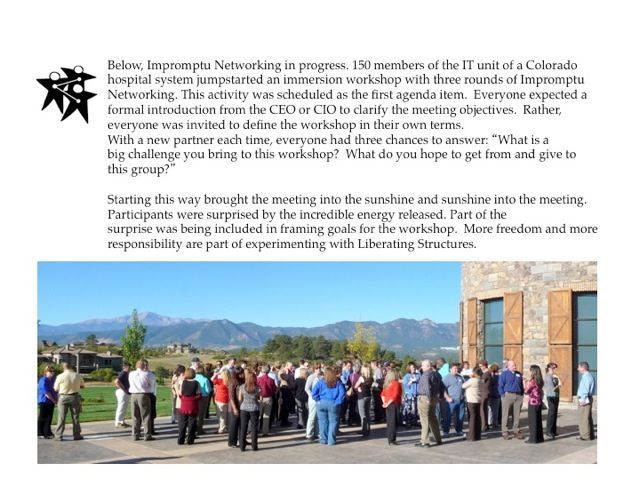![]() Impromptu Networking
Impromptu Networking
Rapidly Share Challenges and Expectations, Build New Connections (20 min.)
What is made possible? You can tap a deep well of curiosity and talent by helping a group focus attention on problems they want to solve. A productive pattern of engagement is established if used at the beginning of a working session. Loose yet powerful connections are formed in 20 minutes by asking engaging questions. Everyone contributes to shaping the work, noticing patterns together, and discovering local solutions.
Five Structural Elements – Min Specs
1. Structuring Invitation
- Ask, “What big challenge do you bring to this gathering? What do you hope to get from and give this group or community?”
2. How Space Is Arranged and Materials Needed
- Open space without obstructions so participants can stand in pairs and mill about to find partners
3. How Participation Is Distributed
- Everybody at once with the same amount of time (no limit on group size)
- Everyone has an equal opportunity to contribute
4. How Groups Are Configured
- Pairs
- Invite people to find strangers or colleagues in groups/functions different from their own
5. Sequence of Steps and Time Allocation
- In each round, 2 minutes per person to answer the questions. 4-5 min. per round
- Three rounds
WHY? Purposes
- Initiate participation immediately for everyone provided the questions are engaging
- Attract deeper engagement around challenges
- Invite stories to deepen as they are repeated
- Help shy people warm up
- Affirm individual contributions to solutions
- Emphasize the power of loose and new connections
- Suggest that little things can make a big difference
Tips and Traps
- Use one challenge question and one give-and-take question
- Ask questions that invite participants to shape the direction of their work together
- Use Impromptu Networking before you begin meetings and conferences
- Use bells (e.g., tingsha) to help you shift participants from first, to second, to third rounds
- Ask questions that are open-ended but not too broad
- Invite serious play
- Have three rounds, not one or two
- If you choose to share output, do it carefully and preserve confidentiality
Riffs and Variations
- Play with different questions: What problem are you trying to solve? What challenge lingers from our last meeting? What hunch are you trying to confirm?
- Taking a group outside a meeting room increases the fun factor
- Link to Social Network Webbing
- Invite participants to make a simple plan to follow up via 15% Solutions
- Make it faster depending on your schedule
- Try a lively variation called Liquid Courage (developed by Jamie Owens - Founder of More Than An Option, Inc. and Keith McCandless). Invite each person, in their pair, to finish these open sentences in 1 minute or less: If only…. They make me… I have to… … that’s just the way it is. If they would ____ then I could ______!
Examples
- For sparking deeper connections on the first day of class, college professors have asked their students, “Why did you choose to attend this class? What do you want to learn from and offer to members of this class?”
- For jump-starting a cross-functional, interdisciplinary learning session, Tim Jaasko-Fisher used Impromptu Networking with judges, lawyers, clerks, and social workers. See “Fixing a Broken Child Welfare System” in Part Three: Stories from the Field.
- For connecting far-flung innovators and disparate prototypes among members of the Innovation Learning Network. See “Inventing Future Health-Care Practice” in Part Three: Stories from the Field.
Attribution: Liberating Structure developed by Henri Lipmanowicz and Keith McCandless. Inspired by June Holley, network weaver.

Above: Al fresco Impromptu Networking in Colorado
